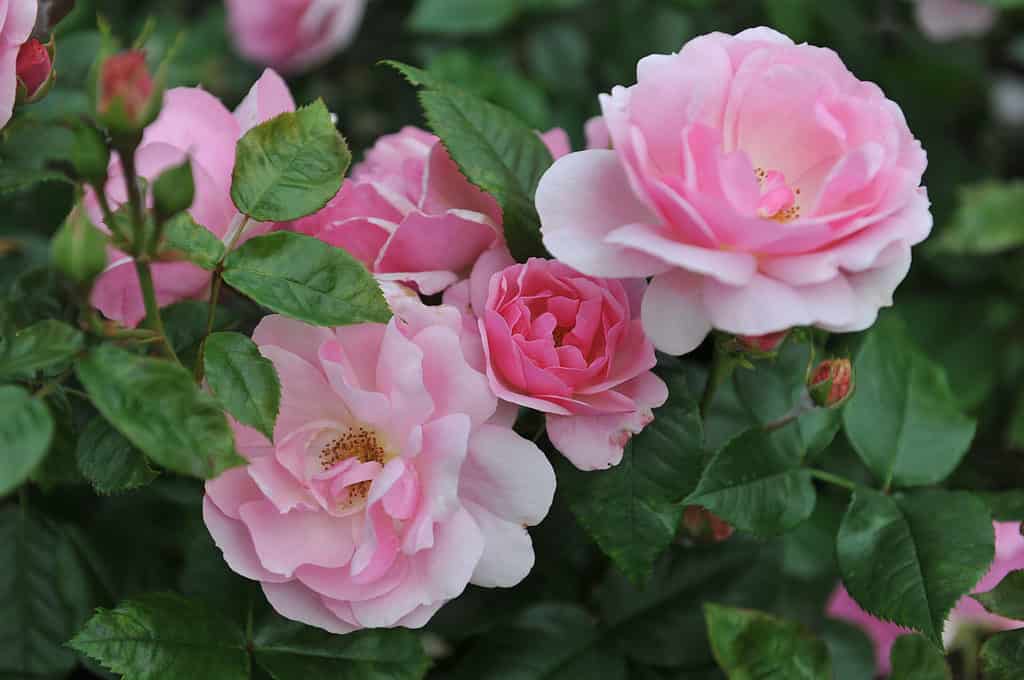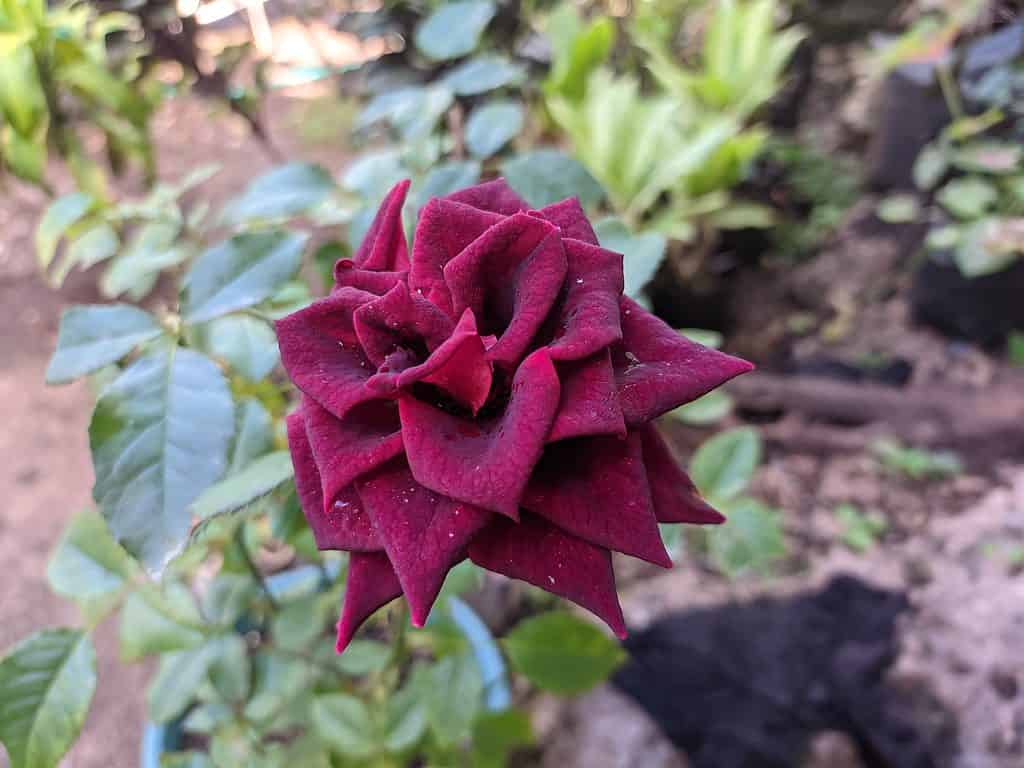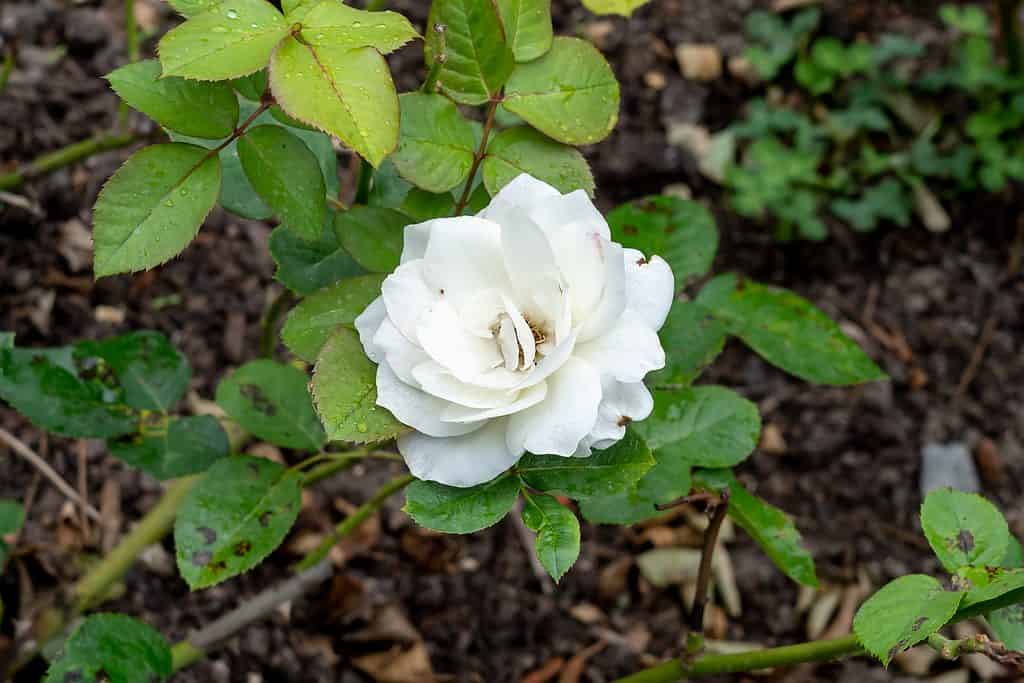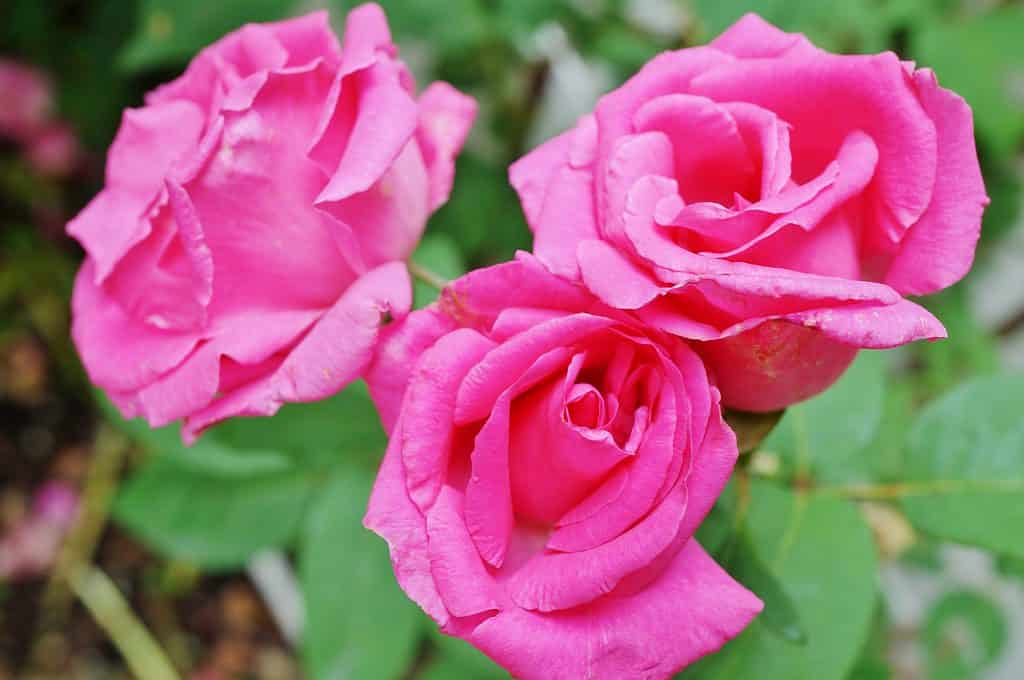Roses used to be thought of as difficult to take care of. However, due to advances in hybridization, it is now much easier for humans to cultivate roses. They are just as easy to grow as other shrub varieties, and the following will do well in Wisconsin.

Types of Roses to Grow in Wisconsin
Roses thrive in the Midwest. They enjoy a cold winter and are less bothered by pests and diseases than roses grown in warmer climates. Here are some exquisite roses to grow in Wisconsin.
1. Double Red Simplicity Hedge Rose

Plant this rose in a sunny spot where the soil is moist but well-drained, and you’ll have lovely red roses in no time.
©PhotoJuli86/Shutterstock.com
The double red simplicity hedge rose provides an array of great features and a sophisticated double-petaled bloom. Throughout the season, vivid crimson flowers appear in bunches over the green, glossy leaves and emit a faint, pleasurable scent.
If you’re looking for a beautiful and low-maintenance rose to grow in Wisconsin, a double red simplicity hedge rose is an excellent choice. This rose can handle humid and rainy climates with ease and can tolerate temperatures as low as -10 degrees. Plant this rose in a sunny spot where the soil is moist but well-drained, and you’ll have lovely red roses in no time.
2. Over the Edge Floribunda Rose

©Sergey V Kalyakin/Shutterstock.com
The over-the-edge floribunda rose is a hardy variety that blooms profusely from late spring to late fall. Its soft golden buds are outlined by a pink ruffle that fades as the flowers open. It has a sweet, spicy scent, and its stems are great for making bouquets.
This is a medium-sized rose with an upright, bushy habit and a healthy amount of foliage. It is quite resistant to disease, which makes it an ideal choice for any novice gardener.
3. Mandarin Sunset Patio Tree Rose

©Foto-Sabine/Shutterstock.com
This particular type of rose has a thick central stem with a floribunda rose on the top, giving it a tree-like appearance. Clusters of 3-inch, bright orange double blooms emerge from late spring to late fall. Planting other sun-loving annuals and perennials beneath the elevated crown of this rose can create an attractive tiered effect.
Patio roses are incredibly versatile and can be a beautiful addition to porches and balconies. They can also make an eye-catching centerpiece. The Mandarin sunset patio tree rose is a perfect choice for those looking to grow roses in Wisconsin.
4. Mister Lincoln Hybrid Tea Rose

The Mister Lincoln hybrid tea is thought of highly among rose enthusiasts.
©Rita95/Shutterstock.com
The Mister Lincoln hybrid tea is thought of highly among rose enthusiasts. When blooming, its dark maroon buds open to a 6-inch fully double flower with up to 40 petals that may turn purple in direct sunlight. Its aroma is similar to melon, and its long-lasting flowers are ideal for cutting and displaying.
Mister Lincoln is a hardy variety of hybrid tea known for its long blooming season and heat resistance. It features tall, vertical stems of dark green leaves, reaching a height of 6 feet and a width of 3 feet, creating a stunning display. This rose requires a sunny spot with moist, well-draining soil in order to thrive. It has been a favorite with rose lovers for decades and is sure to bring beauty to any outdoor space.
5. Moondance Floribunda Rose

Moondance floribunda rose is a tall, healthy bush that has glossy, dark green leaves.
©JHVEPhoto/Shutterstock.com
The Moondance floribunda rose is a highly acclaimed, award-winning flower that blooms in abundance and for an extended period of time, from late spring until late fall. Its buds open to reveal large, creamy white high-centered blossoms with roughly 30 petals each, plus a subtle, sweet raspberry scent. The long stems (18 inches) make them perfect for cutting and making beautiful bouquets.
Moondance floribunda rose is a tall, healthy bush that has glossy, dark green leaves. It is very resilient and can tolerate heat, humidity, and most diseases and mildew. This type of rose is great for landscaping, beds, borders, and hedges in Wisconsin.
6. Zephirine Drouhin Climbing Rose

This is a popular choice for its beauty and abundance of flowers.
©EQRoy/Shutterstock.com
First released in 1868 and still a favorite today, the Zephirine Drouhin climbing rose is an incredibly romantic, aromatic, and vintage variety of roses that remains one of the most desired climbing roses. No other modern rose can match its abundant blossoms, intense raspberry aroma, and long-lasting blooming season. This is a popular choice for its beauty and abundance of flowers.
In the spring and fall, the bright and double-petaled flowers of the Zephirine Drouhin climbing rose come into bloom. Each flower has around 24 petals of a cerise-carmine hue and gives off a powerful raspberry scent. A single blossom is a delight, but an entire vase of them is truly something special.
7. Disneyland Tree Rose

The Disneyland Tree Rose has unique apricot and copper highlights.
©T.Kiya from Japan / CC BY-SA 2.0 – License
This gorgeous combination of orange and pink blossoms appears in large groups on strong stems. Grafted onto a tough 3-foot standard, Disneyland® adds a bright burst of charm to any area! Boasting unique apricot and copper highlights, this rose is free flowering and repeat blooming, with petals around 3 inches wide and a hint of tea rose aroma. Enchanting!
The Disneyland tree rose, created by crossing two well-loved varieties, has been proven to be resistant to the summer heat and humidity in Wisconsin. It continues to look vibrant and healthy throughout the entire season, even in September when temperatures can be high and humid.
Keep Your Roses Healthy
Do your homework. Roses are evaluated based on a few features. The most significant one is their resistance to illnesses. The less effort you have to put into managing disease, the better. When selecting roses, prioritize those that are known to be resistant to fungal ailments like black spots and powdery mildew.
Be sure to provide your roses with what they need to stay healthy. They should ideally get about six hours of direct sunlight, especially in the morning, and the soil should be well-drained and nutrient-rich. Make sure to only water the roots and not the leaves, as this will help prevent the spread of fungal diseases.
When trimming your roses at the beginning of spring, remember to cut them back in a way that will open up the middle of the plant or shrub. Doing this will let in more light and air, which will reduce the chances of fungal growth.
Maintaining a neat garden is essential to keeping your roses healthy. Remove any withered or diseased leaves, which may contain fungal spores that can survive the winter and infect the plant in the spring.
Encourage Good Bugs
Familiarize yourself with the insects that come to your garden. Monitor both the pests and beneficial bugs to ensure a balanced environment. If there is an imbalance, consider ordering beneficial bugs through mail order to help restore the equilibrium.
Having healthy soil with the correct balance of nutrients, moisture, and air is essential for growing roses in Wisconsin. Healthy soil can attract beneficial organisms such as earthworms and insects that help roses thrive by improving soil structure, breaking down organic matter, controlling pests, pollinating flowers, and providing food sources for birds or other wildlife. Earthworms aerate the soil while they tunnel through it, which helps increase water infiltration and root growth. Insects like ladybugs feed on aphids which are a common rose pest in Wisconsin. Pollinators such as bees are also attracted to healthy soils because the flowers nearby provide them with nectar. By having healthy soil, you can encourage these beneficial bugs to come to your garden, which will ultimately benefit your roses!
In order to attract helpful bugs, it is necessary to have a variety of flowering plants that will give nectar and pollen during the entire growing season. This will provide sustenance for beneficial insects in all stages of their lives, not just when they are larvae. For example, the syrphid fly only eats prey during its larval stage, while adults require nectar and pollen. Therefore, the roses in your Wisconsin garden should be supplemented with other sorts of flowering plants.
Summary of 7 Roses That Thrive in Wisconsin
| Number | Rose |
|---|---|
| 1 | Double Red Simplicity Hedge Rose |
| 2 | Over the Edge Floribunda Rose |
| 3 | Mandarin Sunset Patio Tree Rose |
| 4 | Mister Lincoln Hybrid Tea Rose |
| 5 | Moondance Floribunda Rose |
| 6 | Zephirine Drouhin Climbing Rose |
| 7 | Disneyland Tree Rose |
The photo featured at the top of this post is © Rita95/Shutterstock.com
Thank you for reading! Have some feedback for us? Contact the AZ Animals editorial team.






